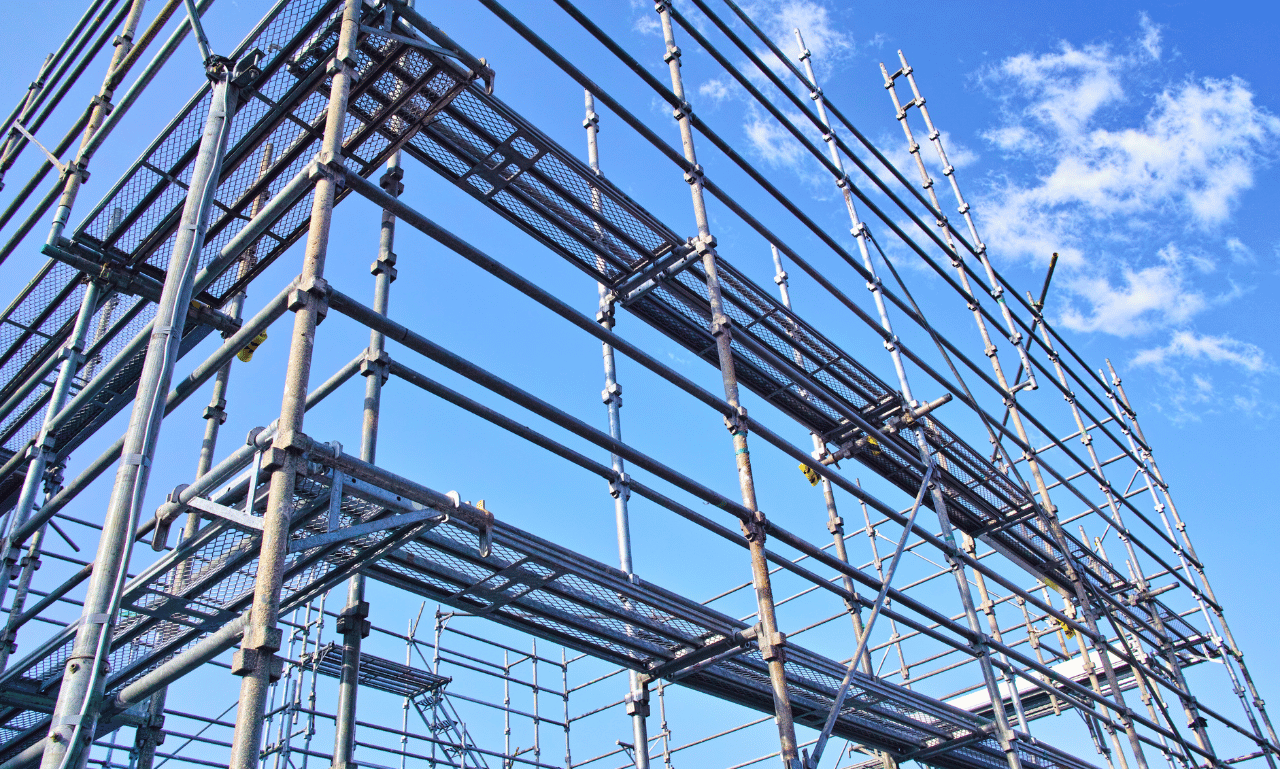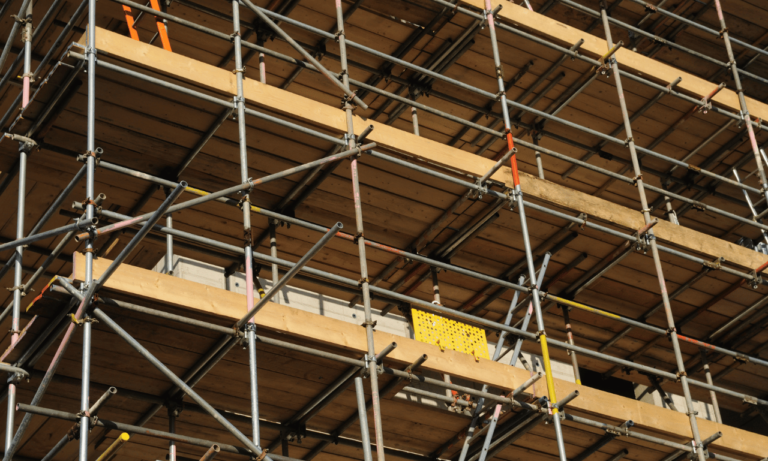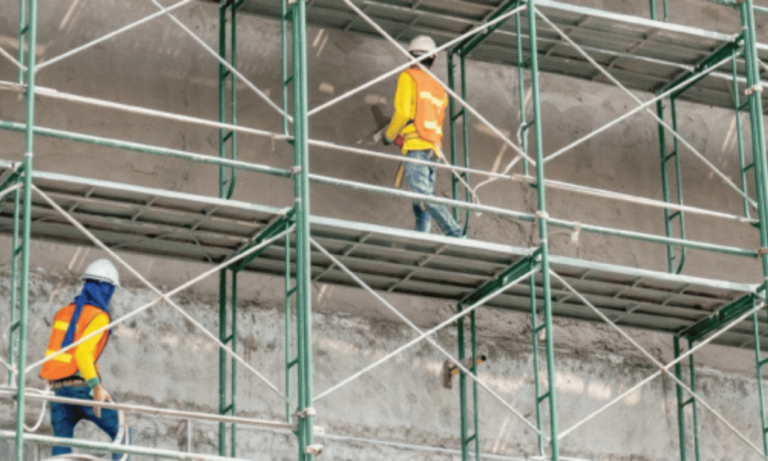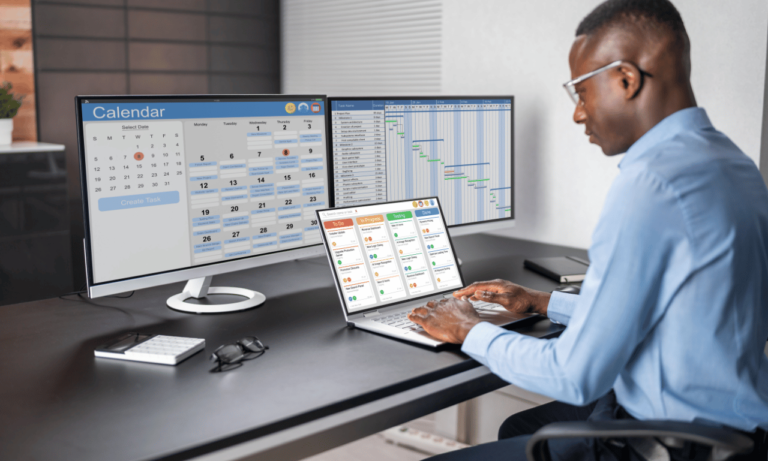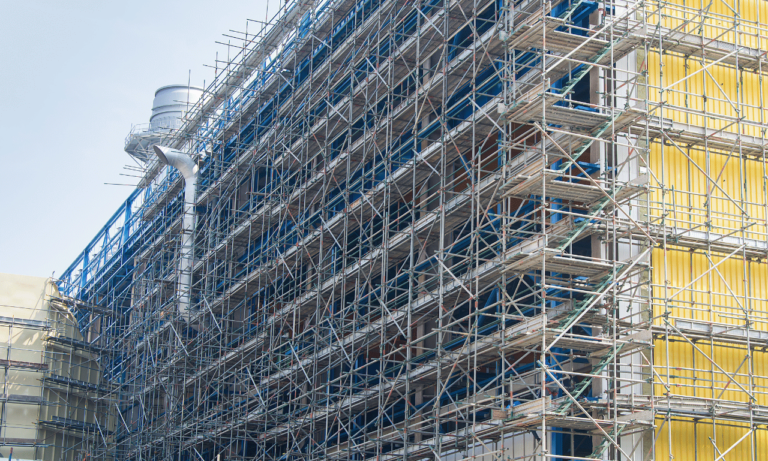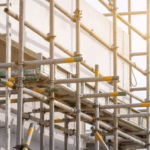Phone:
(+65)8319-0742
Scaffolding plays a vital role in the construction industry, providing workers with access to elevated areas for a variety of tasks. When it comes to using flying scaffolding, safety and efficiency should be top priorities. By following these expert tips, you can ensure the well-being of workers and enhance productivity in high-altitude construction projects.
Key Takeaways:
- Transport flying scaffolding securely to prevent accidents during transportation.
- Cover the entire scaffold with planks whenever feasible to expand the work area and minimize the risk of falls.
- Properly set up the scaffolding by installing base jacks or casters first, followed by cross braces.
- Install guardrails on the platform to prevent accidental falls.
- Maintain a three-point grip while climbing the scaffold and avoid placing weight on cross braces.
Haul Scaffolding Safely
Transporting flying scaffolding requires careful handling to ensure the safety of workers and prevent accidents. By following these essential safety tips, you can securely transport your scaffolding frames and equipment while minimizing risks during transportation.
Stacking Planks, Braces, and Bases
When loading the scaffolding onto a truck bed or trailer, it is crucial to stack the planks, braces, and bases properly. Arrange them on the bottom of the truck bed, between the wheel wells, to create a stable and secure base. This arrangement ensures that the weight is evenly distributed and prevents parts from getting blown or bounced out during transportation.
Avoid Propping Scaffolding Frames on the Side
It is important to avoid propping the scaffolding frames on the side of the truck bed or trailer. This can cause instability and increase the risk of the frames rolling off during transportation. Instead, place the frames flat on the truck bed or trailer and secure them tightly to prevent any movement.
Secure Everything with a Tie-Down Strap
After stacking the planks, braces, and bases securely, use a tie-down strap to secure everything in place. This strap will prevent any parts from becoming loose or falling off during transportation. Ensure that the strap is tightened properly to maintain stability and minimize the risk of accidents when passing pedestrians or encountering road bumps.
Flying Scaffold: Tips for Safety and Efficiency in Construction
Flying scaffolds are a mainstay in the world of construction, offering a temporary structure that is both versatile and mobile. These platforms are crucial for reaching high work areas efficiently and safely. However, ensuring the safety of workers and the efficiency of the construction process requires adherence to specific guidelines and practices. This article delves into essential tips for using flying scaffolds safely and efficiently, exploring their mechanisms and the benefits of various scaffolding systems.
What Are the Key Safety Tips for Using a Flying Scaffold?
How to Conduct a Thorough Inspection?
Before utilizing a flying scaffold, conducting a thorough inspection is paramount. This process involves checking the scaffold platform, cross braces, and guardrails to ensure everything is securely fastened and free from wear and tear. Inspections should be carried out regularly to detect any signs of potential collapse or structural weaknesses. A well-documented inspection routine helps in identifying and addressing issues before they become hazardous, thus reducing the risk of falls and ensuring worker safety.
What Safety Measures Should Be in Place?
Implementing comprehensive safety measures is essential for any construction site. This includes the use of safety harnesses, installation of guardrails, and ensuring that the scaffold is equipped with proper bracing such as diagonal and cross braces. Worker safety can be further enhanced by adhering to established safety guidelines and ensuring that all equipment meets high-quality standards. Regularly maintained scaffolding systems reduce accidental mishaps and contribute to a safer work environment.
How to Train Workers for Safe Scaffold Use?
Proper training is crucial for workers who operate flying scaffolds. Training programs should cover the correct assembly and disassembly of the scaffolding, the use of personal protective equipment, and emergency procedures. Workers should be well-versed in identifying potential hazards and implementing the necessary safety measures. Continuous education and refresher courses help maintain a high level of awareness and competence, thus enhancing the overall safety and efficiency of the construction projects.
Plank the Whole Bay
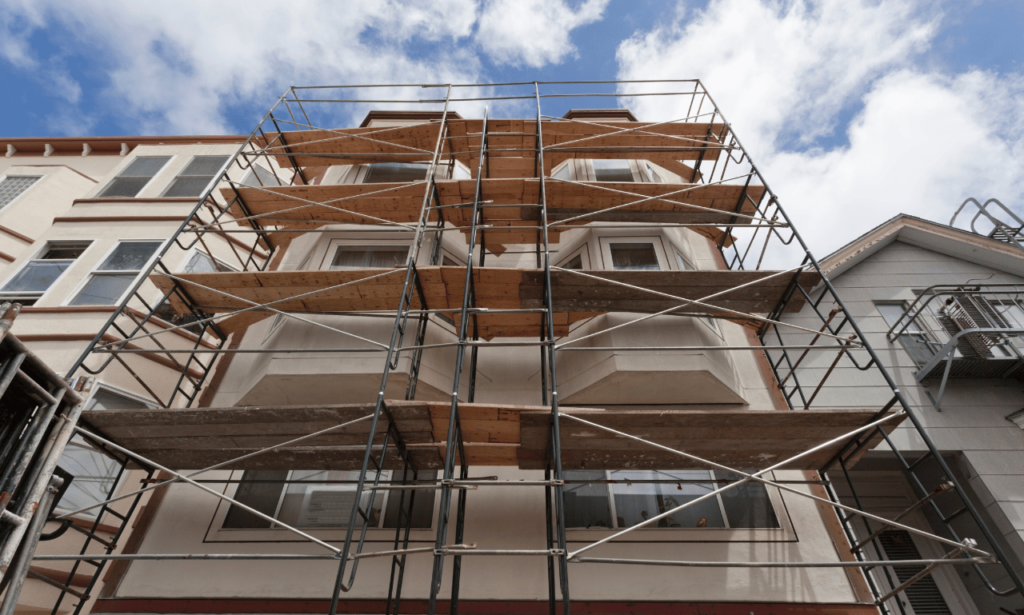
When working with flying scaffolding, ensuring a safe and productive work area is paramount. One effective measure to achieve this is by planking the entire width of the scaffold whenever feasible. This practice creates a larger work area and significantly reduces the risk of falls, enhancing construction safety.
If covering the whole scaffold with planks is not possible due to certain project constraints, another approach is to install additional planks higher up as a guardrail. These additional planks serve as a protective barrier, preventing accidental falls and providing an added layer of fall prevention.
Furthermore, when working on casters, it is essential to use a diagonal “gooser” brace to keep the flying scaffold stable. This brace helps to prevent wobbling or tilting of the scaffold, ensuring a secure and steady working platform, thereby promoting worker safety.
By implementing these measures, construction workers can optimize their work area, minimize fall risks, and prioritize construction safety when using flying scaffolding.
How to Set Up Scaffolding Safely
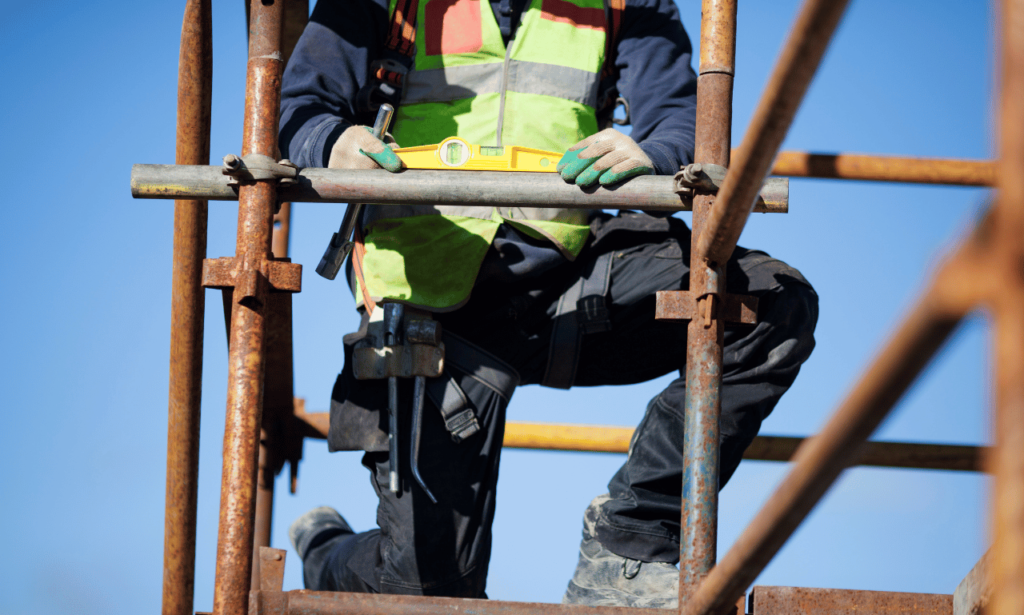
Proper scaffold setup is crucial when working with flying scaffolding to ensure both worker safety and structural stability. By following these step-by-step instructions, you can establish a secure and efficient scaffolding system.
Gather the Necessary Tools and Equipment
Before setting up the flying scaffolding, make sure you have all the required tools and equipment, including base jacks, cross braces, and planks. It’s also essential to have a measuring tape to ensure the correct wall distance.
Step 1: Install the Base Jacks or Casters
Start by installing the base jacks or casters on the first corner of the scaffold. These components provide stability and allow for easy adjustment of the scaffold’s height. By installing them first, you avoid the need to lift the entire scaffold later on.
Step 2: Attach Cross Braces to the First Frame
Next, install both cross braces on one frame of the scaffolding. The cross braces are critical for maintaining structural integrity and preventing the scaffold from swaying or collapsing. Ensure that the cross braces are securely fastened to the frame, further enhancing stability.
Step 3: Position and Attach the Second Frame
Move the second frame into position, aligning it with the first frame. Ensure that the frames are aligned properly and parallel to each other. Attach the cross braces to the second frame, ensuring a secure connection. This step completes the main structure of the scaffolding.
Step 4: Slide the Scaffold 14 Inches from the Wall
Before installing the planks, slide the scaffold approximately 14 inches away from the wall. This distance provides ample space for workers to perform their tasks comfortably and safely. It also helps prevent accidental collisions with the wall and reduces the risk of artifacts falling off due to vibrations.
Step 5: Install the Planks
With the scaffolding properly set up and positioned, it’s time to install the planks. Place the planks across the scaffold, ensuring they are secure and offer a stable walking surface.
Following these instructions will help you establish a safe and sturdy flying scaffolding system. Remember to always adhere to safety guidelines and regulations to protect both workers and the integrity of the construction project.
| Components | Order of Installation |
|---|---|
| Base Jacks or Casters | First |
| Cross Braces | On the first frame |
| Second Frame | Position and attach |
| Planks | Last, after sliding the scaffold from the wall |
Gather the Necessary Tools and Equipment
When working on flying scaffolding, it is crucial to prioritize safety on the platform to prevent accidental falls and injuries. One of the essential safety measures is the installation of a guardrail. A guardrail acts as a protective barrier, providing a physical boundary that helps prevent workers from accidentally falling off the platform.
While safety harnesses are commonly used in various construction scenarios, they are not recommended when working on flying scaffolding. The use of safety harnesses on a flying scaffold can potentially create a dangerous situation. If a fall were to occur while wearing a safety harness, the force exerted on the harness could pull the entire platform down, endangering everyone on it. Therefore, it is best to refrain from using safety harnesses in this specific setting.
To ensure stability and minimize the risk of falls, it is important for workers to maintain a three-point grip while climbing the scaffold. This means that at all times, one hand and two feet (or vice versa) should be in direct contact with the scaffold. By always having at least three points of contact, workers can significantly reduce the chances of slipping or losing balance.
It is essential to note that the cross braces on flying scaffolding are not designed to handle weight. Therefore, climbing or standing on the cross braces is strongly discouraged. Instead, workers should focus on using the proper planks and platforms provided to safely navigate the scaffold while maintaining the three-point grip.
Importance of Guardrail Installation
The installation of a guardrail on the platform of a flying scaffold is crucial for ensuring the safety of workers and preventing accidental falls. When properly installed, guardrails provide a physical barrier that acts as a protective boundary, reducing the risk of workers slipping or falling off the scaffold.
Benefits of Maintaining a Three-Point Grip
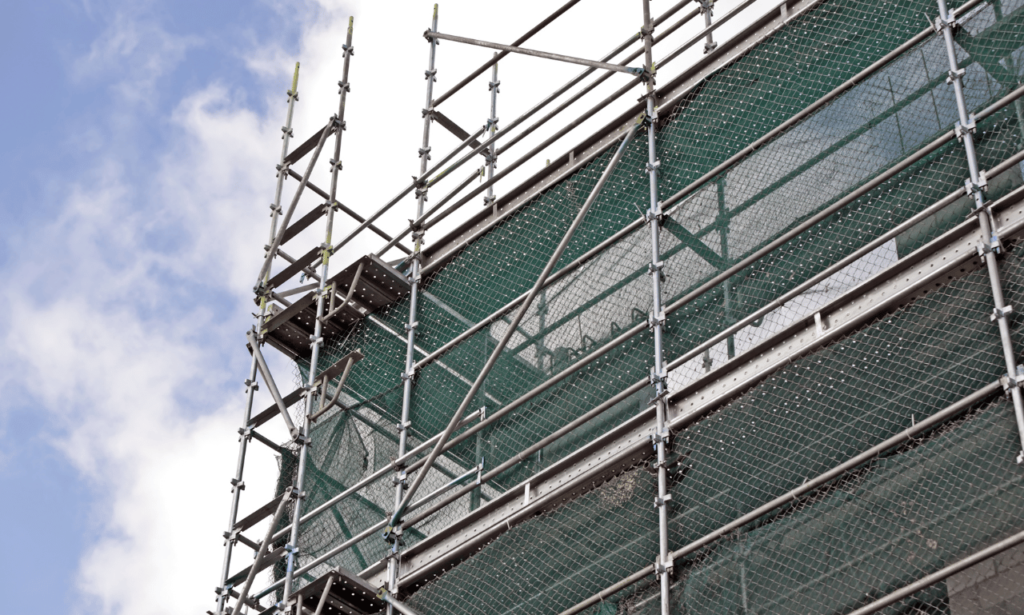
Maintaining a three-point grip, which involves having at least three points of contact with the scaffold, is essential for worker safety. By always having firm contact with the scaffold, workers can reduce the chances of slipping or losing balance, minimizing the risk of falls.
Avoiding the Use of Safety Harnesses
While safety harnesses are crucial in many construction scenarios, they are not recommended when working on flying scaffolding. The use of safety harnesses in this specific setting can potentially create a hazardous situation, as the force exerted on the harness during a fall can pull the entire platform down, endangering workers.
Avoid Climbing on Cross Braces
Climbing or standing on the cross braces of flying scaffolding is strongly discouraged, as these braces are not designed to handle weight. Workers should use the designated planks and platforms to navigate the scaffold safely and maintain stability.
How Does a Flying Scaffold Platform Work?
What Are the Components of a Flying Scaffold?
A flying scaffold consists of various components that work together to provide a stable and secure platform for construction work. Key components include the scaffold platform, masts, braces, beams, and jacks. Each part plays a pivotal role in maintaining the integrity and functionality of the scaffold. High-quality materials and precise assembly are vital to prevent sway and ensure the platform’s stability while in use.
How Is a Flying Scaffold Platform Lifted?
The lifting mechanism of a flying scaffold is typically facilitated by a combination of jacks and masts. The jacks help in raising the platform to the desired height, while the masts provide the necessary support and stability. Proper operation of the lifting mechanism is crucial to ensure the safety and efficiency of the scaffold. Regular inspection and maintenance of these components help prevent mechanical failures and ensure smooth operation.
What Role Does a Mast Play in Stability?
The mast is a critical component that significantly contributes to the stability of a flying scaffold. It acts as the central support structure, helping to evenly distribute weight and prevent the scaffold from swaying or collapsing. A well-secured mast, coupled with appropriate bracing, ensures that the platform remains stable even under challenging conditions. Regular checks and maintenance of the mast are essential to uphold the structural integrity of the scaffold.
What Are the Benefits of Using a Ringlock Scaffolding System?
How Does Ringlock Enhance Flexibility?
The ringlock scaffolding system is renowned for its flexibility and modular design. This system allows for quick and easy assembly and disassembly, making it an ideal choice for construction projects with tight schedules. The modular nature of ringlock scaffolds enables builders to adapt the structure to various configurations, catering to the specific needs of different work areas. This adaptability significantly enhances construction efficiency and productivity.
What Makes Ringlock Safer Than Other Systems?
Ringlock scaffolding systems are designed with safety in mind. They feature a robust locking mechanism that secures each component firmly in place, reducing the risk of accidental disassembly or collapse. The use of high-quality materials and precision engineering further ensures the safety and durability of the system. Additionally, the design accommodates comprehensive safety measures, such as guardrails and braces, to enhance worker protection.
How Does Ringlock Contribute to Efficiency?
Efficiency in construction is often linked to the ease of scaffold assembly and adaptability. The ringlock system excels in both areas, allowing for rapid setup and adjustment with minimal tools required. This efficiency translates to reduced labor costs and shorter project timelines. Moreover, the durability and reliability of ringlock scaffolds mean fewer interruptions for repairs, ensuring that construction processes remain on schedule.
How to Choose the Right Scaffolding Supplier?
What to Look for in a Reliable Supplier?
Choosing the right scaffolding supplier is crucial for ensuring the safety and success of construction projects. A reliable supplier should offer high-quality scaffolding solutions and provide comprehensive support services, including installation guidance and maintenance. It’s important to evaluate the supplier’s reputation, customer reviews, and industry certifications to ascertain their reliability and expertise.
How to Evaluate the Quality of Scaffoldings?
Evaluating the quality of scaffoldings involves examining the materials used, the design of the scaffolding system, and the supplier’s adherence to industry standards. High-quality scaffolding should be robust, durable, and capable of withstanding the demands of a construction site. Additionally, the presence of safety features such as guardrails and secure locking mechanisms is indicative of a superior product.
What Are the Cost Considerations?
Cost is a significant factor when selecting scaffolding, but it should not compromise quality and safety. While budget constraints are understandable, opting for cheaper, lower-quality scaffolding can lead to higher long-term costs due to repairs and safety risks. It’s crucial to balance cost considerations with the value offered by the supplier, ensuring that the chosen scaffold meets safety and efficiency requirements without breaking the bank.
What Are the Best Practices for Scaffolding Inspection?
How Often Should Inspections Be Conducted?
Regular inspections are a cornerstone of scaffold safety. It’s recommended to conduct inspections before each use and periodically during prolonged projects. Additionally, inspections should be performed after any event that could affect scaffold stability, such as severe weather. Frequent checks help in identifying potential issues early and implementing corrective measures promptly.
What Are the Common Issues to Look For?
Common issues to look for during scaffold inspections include loose or missing components, damaged platforms or planks, and signs of wear on braces and connections. Inspectors should also ensure that all guardrails are in place and that the scaffold is free from debris that could pose tripping hazards. Identifying these issues early can prevent accidents and ensure a safe working environment.
How to Document and Address Inspection Findings?
Documenting inspection findings is crucial for maintaining a record of the scaffold’s condition and any repairs or adjustments made. Detailed reports should be kept, highlighting any deficiencies found and the actions taken to address them. This documentation not only helps in tracking the scaffold’s maintenance history but also serves as evidence of compliance with safety regulations. Addressing findings promptly minimizes risks and ensures the scaffold remains a safe and efficient tool for construction.
Note:
It is crucial to ensure that all workers receive proper training on the safe use of flying scaffolding and adhere to the provided safety guidelines. By prioritizing safety on the platform and implementing these precautions, construction teams can create a secure working environment even at high altitudes.
Conclusion
Prioritizing safety and efficiency when using flying scaffolding is vital in the construction industry. By following expert tips and guidelines, workers can significantly reduce the risk of accidents and improve productivity at high altitudes.
Transporting scaffolding safely using proper stacking techniques and tie-down straps ensures that parts remain secure during transportation, preventing accidents and injuries. Planking the entire scaffold or installing additional planks higher up as a guardrail creates a larger work area and minimizes the risk of falls.
Setting up flying scaffolding properly by starting with the base jacks or casters and installing cross braces on both frames ensures stability and structural integrity. Maintaining safety on the platform by installing guardrails and avoiding climbing on cross braces adds an extra layer of protection against potential accidents.
By using appropriate fall protection gear, such as safety harnesses and employing the three-point grip rule while climbing the scaffold, workers can maintain their safety and confidence. These safety tips, when followed diligently, contribute to a secure construction environment, allowing workers to perform their tasks efficiently and safely in the high-pressure industry.
FAQ
How can I safely transport flying scaffolding?
To safely transport flying scaffolding, stack the planks, braces, and bases on the bottom between the wheel wells. Avoid propping the scaffolding frames on the side of the truck bed and secure everything with a tie-down strap. This prevents parts from getting blown or bounced out and minimizes the risk of accidents when passing pedestrians.
Should I cover the entire width of the scaffold with planks?
Yes, whenever possible, it is best to cover the entire width of the scaffold with planks. This creates a larger work area and reduces the risk of falls. If covering the whole scaffold is not feasible, install additional planks higher up as a guardrail. When working on casters, use a diagonal “gooser” brace to keep the scaffold stable.
How do I set up flying scaffolding?
When setting up flying scaffolding, start by installing the base jacks or casters first. This prevents the need to lift the entire scaffold to insert them. Next, install both cross braces on one frame, ensuring stability. Then, move the second frame into position and attach the cross braces to that as well. Finally, slide the scaffold approximately 14 inches from the wall before installing the planks.
Should I use safety harnesses when working on flying scaffolding?
No, safety harnesses are not necessary when working on flying scaffolding, as they can potentially pull the entire platform down if a fall occurs. Instead, it is crucial to install a guardrail on the platform to prevent accidental falls. Maintain a three-point grip while climbing the scaffold by keeping one hand and two feet (or vice versa) in contact with the scaffold at all times. Avoid climbing on the cross braces, as they are not designed to handle weight.
Why is it important to prioritize safety and efficiency when using flying scaffolding?
Prioritizing safety and efficiency when using flying scaffolding is vital in the construction industry. By following expert tips, such as transporting scaffolding safely, planking the entire scaffold, setting it up properly, ensuring safety on the platform, and using appropriate fall protection gear, you can significantly reduce the risk of accidents and improve productivity. Adhering to these guidelines allows workers to work confidently and safely at high altitudes.

